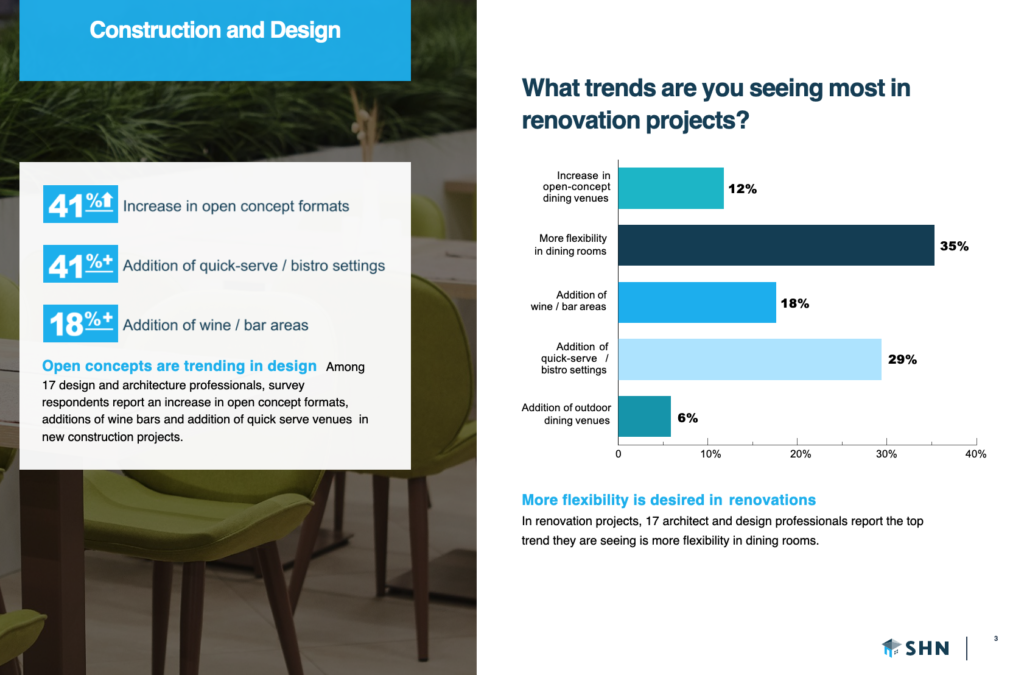Senior living residents are going to want to socialize when they emerge from isolation — and providers will likely need to adjust their dining programs in order to cater to their newly busy lifestyles.
From more grab-and-go meal kits and staggered mealtimes to mobile ice cream carts and online grocery shopping platforms, residents in social isolation have learned to adapt and become more flexible in how and what they eat. And senior living providers must be prepared to cater to a similar level of flexibility once the pandemic ends, according to Regan Medzhibzher, a vice president of marketing and communications with Atlanta-based hospitality services company Morrison Living, which is part of the Compass Group.
“As devastating as Covid-19 has been, it has, in some ways, been a catalyst to the future of dining across many industries, from restaurants to senior living,” Medzhibzher said on a Senior Housing News webinar held Wednesday afternoon. “Things that we are seeing continuing as trends are: flexibility in service offerings and experience, customization … awareness around sanitation and service styles, and adaptability.”
These ideas don’t run counter to what many stakeholders in the senior living industry are already doing, according to a recent Senior Housing News survey. The survey, conducted in the pre-pandemic months of November 2019 to February 2020, polled more than 50 senior living operations professionals, 17 architects and 500 consumers.
Flexible feasting on new types of food
Morrison, which provides dining services to about 500 senior living communities nationwide, has noticed an uptick in convertible dining spaces. The company also recently launched a new grab-and-go line called Jack and Olive, which carries packaged sandwiches, salads and desserts.
“We’re designing spaces that flex from a coffee shop in the morning, to a bistro or teaching kitchen during lunch, to a bar or private dining space in the evening,” Medzhibzher said. “And then if you look at the results around quick-serve and bistro settings, we are really seeing that addition happening across the country.”
More than a third (35%) of the surveyed architects said they noticed an emphasis on more flexibility in dining room renovations, and 29% have seen more renovation projects centered around adding a quick-serve venue or bistro.
 Tim Regan
Tim ReganThe surveyed senior living providers also said they’re offering new kinds of foods in their communities, including some that wouldn’t have been on their radar one or two years ago. These include many of the trends U.S. grocer Whole Foods identified as up-and-coming in 2019, such as new integrations of fat sources like coconut butter (56%); flavors inspired by the “Pacific Rim” of Asia, Oceania and the western coasts of North and South America (41%); shelf-stable probiotics (30%) and faux-meat offerings (24%).
Providers are introducing these trends to residents in innovative ways. For example, before the Covid-19 pandemic, a Morrison partner community in Miami joined with students from the University of Miami to offer a blind taste-test between a full beef patty and the Impossible Burger.
“I would have put money on our residents choosing that angus beef burger,” Medzhibzher said. “But I [would have] lost a lot of money that day, because they chose the Impossible Burger.”
Current and prospective senior living residents, meanwhile, identified quality and flavor of food, number of menu choices, and healthy and nutritious options as what they’re most interested in when it comes to talking about dining with staff.
 Tim Regan
Tim ReganThis underscores the need for senior living providers to offer a consistent level of quality across their entire dining program and care continuum, from independent living to assisted living and skilled nursing, Medzhibzher added.
And while residents are becoming comfortable with more in-room meals and shopping, they’re also enjoying desserts from ice cream carts and drinks from rolling happy hours. And while they won’t necessarily want all of those offerings when they emerge from self-isolation, but residents will likely expect the same level of flexibility in the future.
“That’s going to be the minimum expectation of tomorrow’s residents,” Medzhibzher said. “In today’s market, you must give them what they want, when they want it, and very soon, how they want to pay for it.”
Tech at the forefront
Residents are also becoming increasingly savvy regarding digital offerings, such as online food ordering or grocery delivery services. The forced social isolation of the Covid-19 pandemic has only boosted this trend.
“Some demographics, like older consumers, may have been previously uncomfortable with buying groceries or other goods online, but the coronavirus has forced them to get comfortable,” Medzhibzher said. “Once they fall into the new routine and get used to the ease of delivery at their door, shoppers may be hard-pressed to return to brick-and-mortar.”
Sanitization is another hot topic amid Covid-19. Across the industry, providers have started implementing new practices to clean communities from top to bottom. And that trend is likely to continue.
“New innovations such as knife sanitizers, air purifiers, and even ice machine sanitizers will soon live in several, if not most communities,” Medzhibzher said.
Other top findings from the survey include:
— More than half (61%) of the consumer respondents said they would not pay an optional monthly surcharge for better or premium food choices, while 39% said they would.
— More than 75% of the survey’s consumer respondents rated dining a 3 out of 5 or higher in terms of importance when considering moving into a senior living community.
— Slightly less than 60% of senior living providers said they are actively pursuing additional revenue sources from dining, while just over 40% said they are not.

